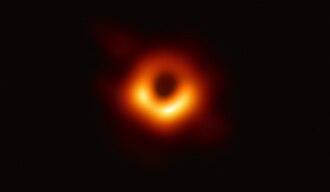Liang hideung badag kacida
Liang hideung badag kacida nu dipikawanoh dina basa Inggris salaku supermassive black hole disingget SMBH atawa SBH téh hiji liang hideung, anu miboga massa aya kana ratusan rébu, jutaan, atawa miliaran kalina massa panonpoé (M☉). Ari liang hideung sorangan nyaéta objék astronomi nu geus ngarandapan runtagna gravitasi, nyésakeun hiji daérah rohang angkasa nu bentukna buleud, di dinya, moal aya hiji-hiji acan benda nu bakal bisa ngaléos, kaasup cahya. Tina bukti-bukti nu geus katénjo, ampir unggal galaksi miboga liang hideung gedé kacida dina puseurna.[4][5] Kawas, galaksi catang bobo (milky way) boga liang hideung gedé kacida nu luyu jeung sumber radio Sagitarius A*.[6][7] Akrési gas unggalbéntang kana liang hideung gedé kacida téh prosés anu boga papancén pikeun méré tanaga keur inti galaksi aktif (AGN) jeung quasar.[8]

Béréndélan pabukuan
édit- ↑ Overbye, Dennis (2019-04-10). "Black Hole Picture Revealed for the First Time – Astronomers at last have captured an image of the darkest entities in the cosmos – Comments". The New York Times. https://www.nytimes.com/2019/04/10/science/black-hole-picture.html?comments#permid=31473598. Diakses pada April 10, 2019
- ↑ The Event Horizon Telescope Collaboration (April 10, 2019). "First M87 Event Horizon Telescope Results. I. The Shadow of the Supermassive Black Hole". The Astrophysical Journal Letters 875 (1): L1. arXiv:1906.11238. Bibcode 2019ApJ...875L...1E. doi:10.3847/2041-8213/ab0ec7.
- ↑ The Event Horizon Telescope Collaboration; Akiyama, Kazunori; Alberdi, Antxon; Alef, Walter; Asada, Keiichi; Azulay, Rebecca; Baczko, Anne-Kathrin; Ball, David et al. (2019-04-10). "First M87 Event Horizon Telescope Results. V. Physical Origin of the Asymmetric Ring". The Astrophysical Journal 875 (1): See especially Fig. 5. arXiv:1906.11242. Bibcode 2019ApJ...875L...5E. doi:10.3847/2041-8213/ab0f43. ISSN 2041-8213.
- ↑ Kormendy, John; Richstone, Douglas (1995), "Inward Bound—The Search For Supermassive Black Holes In Galactic Nuclei", Annual Review of Astronomy and Astrophysics 33: 581, Bibcode:1995ARA&A..33..581K, doi:10.1146/annurev.aa.33.090195.003053
- ↑ Kormendy, John; Ho, Luis (2013). "Coevolution (Or Not) of Supermassive Black Holes and Host Galaxies". Annual Review of Astronomy and Astrophysics 51 (1): 511–653. arXiv:1304.7762. Bibcode 2013ARA&A..51..511K. doi:10.1146/annurev-astro-082708-101811.
- ↑ Ghez, A.; Klein, B.; Morris, M.; Becklin, E (1998). "High Proper-Motion Stars in the Vicinity of Sagittarius A*: Evidence for a Supermassive Black Hole at the Center of Our Galaxy". The Astrophysical Journal 509 (2): 678–686. arXiv:astro-ph/9807210. Bibcode 1998ApJ...509..678G. doi:10.1086/306528.
- ↑ Schödel, R. (2002). "A star in a 15.2-year orbit around the supermassive black hole at the centre of the Milky Way". Nature 419 (6908): 694–696. arXiv:astro-ph/0210426. Bibcode 2002Natur.419..694S. doi:10.1038/nature01121. PMID 12384690.
- ↑ Frank, Juhan; King, Andrew; Raine, Derek J. (January 2002). "Accretion Power in Astrophysics: Third Edition". Accretion Power in Astrophysics. Cambridge, UK: Cambridge University Press. Bibcode:2002apa..book.....F. ISBN 0521620538.